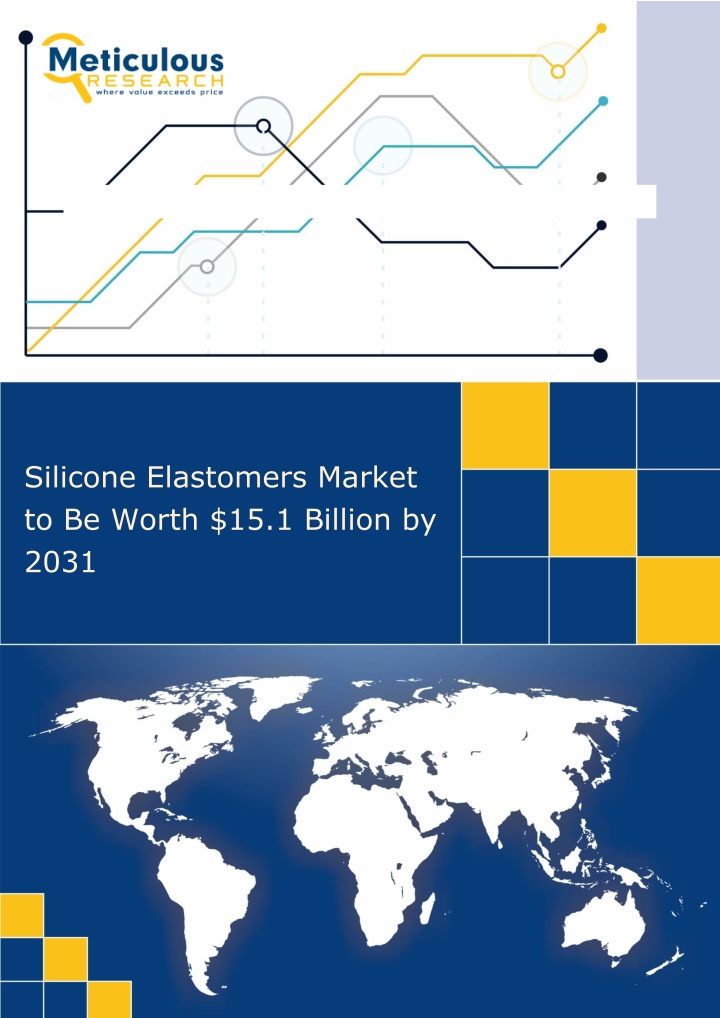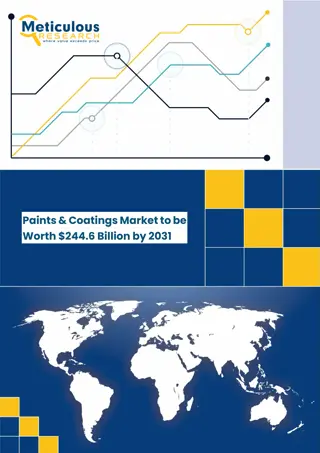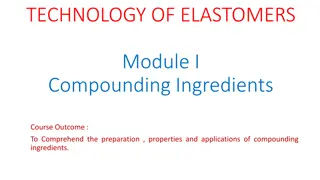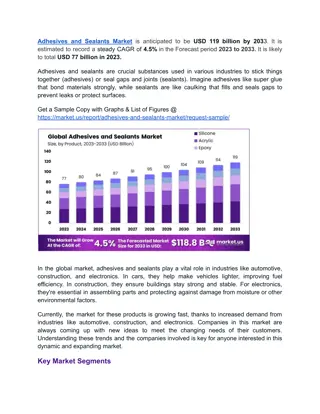
Silicone Elastomers Market
The Silicone Elastomers Market is Expected to Reach $15.1 Billion by 2031, at a CAGR of 7.9% from 2024 to 2031.n
Download Presentation

Please find below an Image/Link to download the presentation.
The content on the website is provided AS IS for your information and personal use only. It may not be sold, licensed, or shared on other websites without obtaining consent from the author. If you encounter any issues during the download, it is possible that the publisher has removed the file from their server.
You are allowed to download the files provided on this website for personal or commercial use, subject to the condition that they are used lawfully. All files are the property of their respective owners.
The content on the website is provided AS IS for your information and personal use only. It may not be sold, licensed, or shared on other websites without obtaining consent from the author.
E N D
Presentation Transcript
Silicone Elastomers Market to Be Worth $15.1 Billion by 2031
Global Silicone Elastomers Market 2024-2031 Meticulous Research a leading global market research company, published a research report titled, Silicone Elastomers Market by Type (Liquid Silicone Rubber (LSR), High- temperature Vulcanize (HTV)), Process (Automotive,Healthcare, Electrical & Electronics, Construction), and Geography - Global Forecast to 2031. (Extrusion, Molding), End-use Industry According to this latest publication from Meticulous Research , the silicone elastomers market is projected to reach $15.1 billion by 2031, at a CAGR of 7.9% from 2024 2031. The growth of the silicone elastomers market is driven by the increasing utilization of silicone elastomers across medical devices, developments in material science, and high demand for silicone elastomers in the electrical & electronic industry. However, environmental concerns, sustainability issues, and stagnant growth in developed countries restrain the growth of this market. Furthermore, the integration of silicone elastomer with IoT devices and increasing demand for silicone elastomer for automobiles are expected to generate growth opportunities for the stakeholders in this market. However, fluctuations in raw material prices is a major challenge impacting the growth of the silicone elastomers market. The silicone elastomers market is segmented by type (room-temperature vulcanize (RTV), liquid silicone rubber (LSR), high-temperature vulcanize (HTV)), by process (extrusion process, molding process (injection molding process, transfer molding process, compression molding process, other molding processes), calendering process, other processes), end-use industry (automotive, aviation & aerospace, consumer goods, electrical & electronics, healthcare, energy, industrial machinery, construction, other end-use industries). The study also evaluates industry competitors and analyzes the market at the regional and country levels. Based on type, the silicone elastomers market is segmented into room-temperature vulcanize (RTV), liquid silicone rubber (LSR), and high-temperature vulcanize (HTV). In 2024, the high-temperature vulcanize (HTV) segment is expected to account for the largest share of above 52% of the silicone elastomers market. The large market share of this segment is attributed to the advancements in manufacturing technologies; increasing demand for HTV in various industries such as automotive, aerospace, healthcare, and electronics, where high temperatures are prevalent; and increasing use of HTV for manufacturing of gaskets, seals, and components in engines and appliances in the electronic industry. The demand for HTV continues to increase as industries continue to prioritize safety, efficiency, and durability in their products and processes. However, the liquid silicone rubber (LSR) segment is projected to register the highest CAGR during the forecast period. The segment's growth is attributed to the innovations and development in material science, increasing demand for biocompatible material, and increasing high-volume production of complex parts in the automotive, healthcare, and Page 1 of 4 Meticulous Research| sales@meticulousresearch.com
Global Silicone Elastomers Market 2024-2031 electronics sectors. In March 2021, The Dow Chemical Company (U.S.) launched low-density liquid silicone rubber (LSR) for injection molding for various applications such as food dosing valves, closures, dispensers, seals, gaskets, and food contact applications in Europe and North America. Based on process, the silicone elastomers market is segmented into extrusion process, molding process, calendering process, and other processes. In 2024, the molding process segment is expected to account for the largest share of above 45% of the silicone elastomers market. The large market share of this segment is attributed to the increasing demand for LSR injection molding for the creation of complex parts, advancements in molding technologies and material science, and the growing demand for molding process for mass production of silicone elastomer parts across various industries. Moreover, this segment is also projected to register the highest CAGR during the forecast period. Based on end-use industry, the silicone elastomers market is segmented into automotive, aviation & aerospace, consumer goods, electrical & electronics, healthcare, energy, industrial machinery, construction, and other end-use industries. In 2024, the electrical & electronics segment is expected to account for the largest share of above 35% of the silicone elastomers market. The large market share of this segment is attributed to the increasing use of silicone elastomers for manufacturing various components such as power supplies, circuit boards, and LED lighting components; increasing demand for high- performance and reliable electronic devices; and growing trend towards smaller and more compact electronic devices. Manufacturers are integrating multiple functions in electronic devices and encapsulating silicone elastomers for protection against shock, vibration, and environmental factors. Certain formulations offer inherent fire resistance, providing an extra layer of safety in electronics prone to overheating. However, the healthcare segment is projected to register the highest CAGR during the forecast period. The segment's growth is attributed to the increasing demand for biocompatible material for medical devices, increasing use of silicone elastomers to create controlled-release drug delivery devices to slowly release medication into the body, and increasing demand for silicone elastomers for various implants, such as breast implants, heart valves, and stents. In April 2023, DuPont de Nemours, Inc. (U.S.) launched Liveo Silicone Elastomer Blends to meet the growing consumer demand for products that address a range of troubling skin conditions such as scars, actinic keratosis, atopic dermatitis, psoriasis, and other skin conditions. Based on geography, the silicone elastomers market is segmented into North America, Europe, Asia-Pacific, Latin America, and the Middle East & Africa. In 2024, Asia-Pacific is expected to account for the largest share of above 53% of the silicone elastomers market. The market growth in Asia-Pacific is driven by the growth of the rapid economic development in Asian countries, particularly China and India, the growing healthcare industry in the region, increasing use of silicone elastomer in the construction sector due to Page 2 of 4 Meticulous Research| sales@meticulousresearch.com
Global Silicone Elastomers Market 2024-2031 increasing government investments in infrastructure projects across the region, and increasing adoption of silicone elastomers across various industries in countries such as South Korea, Japan, and Southeast Asian countries. China has become a major manufacturing hub for various industries that use silicone elastomers. For instance, in September 2023, Wacker Chemie AG (Germany) expanded its specialty silicone manufacturing capacities in China to manufacture functional silicone fluids, silicone emulsions, and silicone elastomer gels. Moreover, this region is also projected to record the highest CAGR of above 9% during the forecast period. Key Players The key players operating in the silicone elastomers market are Momentive Performance Materials, Inc. (U.S.), China National Bluestar (Group) Co, Ltd. (China), The Dow Chemical Company (U.S.), Shin-Etsu Chemical Co., Ltd. (Japan), Wacker Chemie AG (Germany), DuPont de Nemours, Inc. (U.S.), Specialty Silicone Products, Inc. (U.S.), Reiss Manufacturing, Inc. (U.S.), MESGO S.p.A.(Italy), Rogers Corporation (U.S.), Stockwell Elastomerics, Inc. (U.S.), Zhejiang Xinan Chemical Industrial Group Co., Ltd. (China), Marsh Bellofram Group of Companies (U.S.), Cabot Corporation (U.S.), and CHT Germany GmbH (Germany). Download @ https://www.meticulousresearch.com/download-sample- report/cp_id=5844 Sample Report Here Key Questions Answered in the Report: What are the high-growth market segments in terms of the type, process, and end- use industry? What is the historical market size for the silicone elastomers market? What are the market forecasts and estimates for 2024 2031? What are the major drivers, restraints, opportunities, challenges, and trends in the silicone elastomers market? Who are the major players in the silicone elastomers market, and what are their market shares? What is the competitive landscape like? What are the recent developments in the silicone elastomers market? What are the different strategies adopted by major market players? What are the trends and high-growth countries? Who are the local emerging players in the silicone elastomers market, and how do they compete with other players? Page 3 of 4 Meticulous Research| sales@meticulousresearch.com
Global Silicone Elastomers Market 2024-2031 Contact Meticulous Email- sales@meticulousresearch.com Contact Connect with us on research Us: Research Sales- +1-646-781-8004 LinkedIn- https://www.linkedin.com/company/meticulous- Page 4 of 4 Meticulous Research| sales@meticulousresearch.com











